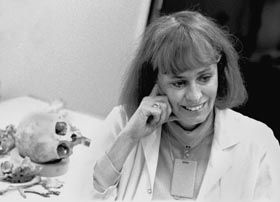
| ||
 | ||
 Kathy Reichs with the tools of her trade PHOTO: OWEN EGAN |
Telling more stories of the dead
|
TOD HOFFMAN | It isn't true that dead men tell no tales. Quite the contrary, in fact.
They have fascinating, intricate and incredibly detailed stories to tell. But they need someone of particular skills to articulate on their behalf. Enter the forensic examiners who can read the clues off the corpse and reconstruct the mystery in the murder. Enter people like Kathy Reichs, forensic anthropologist, and Robert Dorion, forensic dental surgeon, among the most prominent figures in their profession, both of whom lend their expertise to the Quebec Public Security Ministry's Laboratoire de sciences judiciaires et de médecine légale and lecture at McGill. Together they held a sell-out audience of 180 rapt with grim anecdotes and slides of gruesome exhumations and grisly disfigurements in a lecture presented by the McGill Society of Montreal in the Leacock Building on March 9. Already eminent in a field practiced by only 50 certified members of the American Board of Forensic Anthropology, Reichs gained wide public recognition in 1997 with the success of her debut novel, Déjà Dead. "All of the science in the book is accurate," she said. "I wanted to give a sense of how it's employed in solving crime. To come up with the serial murders that make up the plot, I stitched together pieces of several cases." Prominent among these were the 1992 murders committed by Serge Archambault. Reichs was involved in the retrieval and analysis of the corpse of one of his victims. Déjà Dead is set in Montreal, a city the Chicago native first visited in 1989 on a faculty exchange between the University of North Carolina, where she is still on faculty as an anthroplogy professor, and Concordia University. Along with her forensics duties for the province, she has been a visiting professor at McGill, though her teaching is currently on hold due to a hectic writing schedule. Reichs used the occasion as an opportunity to drop tantalizing hints about her second novel, Death du Jour, due out in June. It, too, was inspired by real events, in this case by the exhumation of Jeanne Leber, the celebrated recluse of Westmount, who died in 1714 and has been proposed for sainthood. She ties this personage in with the Solar Temple cult murder-suicides that took place in Quebec, France, and Switzerland, claiming a total of 74 lives between 1994 and 1997. The book marks the return of her Déjà Dead heroine, Dr. Temperance Brennan who, like her creator, is a forensic anthropologist. "And that's all I'm going to tell you," she concluded coyly. Not only does a corpse reveal sex, age, race and other information critical for identification, but the cause of death, the probable weapon involved, and even something about the killer. For instance, in the Archambault case, the manner in which the victim had been mutilated suggested someone familiar with dismemberment. Sure enough, Archambault had worked as a butcher. Not only that, but the particular pattern of cuts left in bone by knives and saws can be analyzed to identify specific implements used in the murder. What happens when a body is so badly destroyed that little physical evidence survives? This is the preserve of the forensic dentist. Teeth are the most durable part of the human body from which positive identifications are possible. Useful as it is in individual deaths, forensic dentistry is an especially valuable tool in the case of mass disasters, such as plane crashes. But, as Dorion pointed out, he is the only forensic medical examiner who is also called upon to treat living victims. "Bite pattern evidence is like a fingerprint," he explained. "We can measure it to determine who might have inflicted a wound, say, in a child abuse case. And we can use it to identify the dentition when the assailant isn't human, but, for instance, a dog." Dorion is a graduate of McGill (DDS'72) and lectures on forensic dentistry, as well as maintaining a private practice. Since even the relatively sanitary slides Reichs and Dorion presented had some in the audience flinching, the obvious question of why one chooses their profession came up. "I began in bio-archaeology, studying very old remains," responded Reichs. "Because of my expertise in bone analysis, the police began bringing me remains of old corpses to examine. I ended up concentrating in this area because of the appeal of its immediacy." And coping with the stench and the gore? "You learn to be clinical." But she added, "At the same time, you are responsible for treating the remains as human beings and for giving them back their identity."
|
|
| |||||